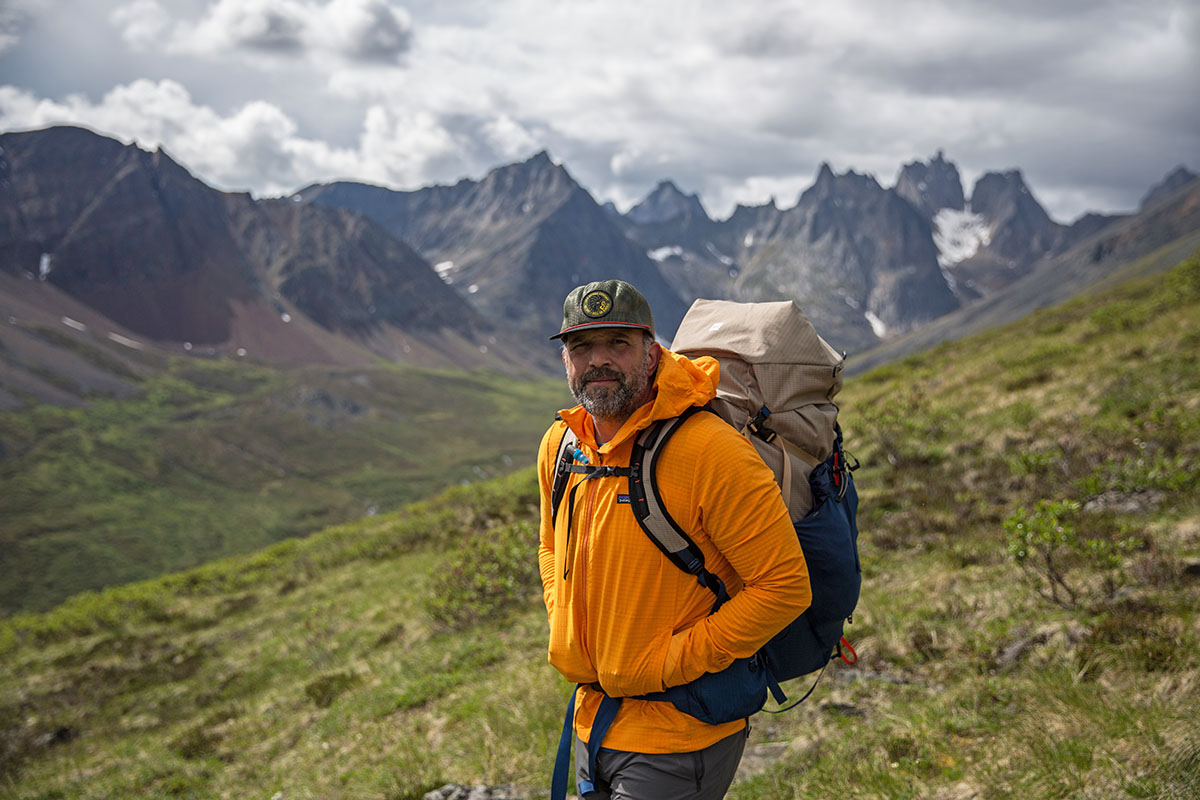
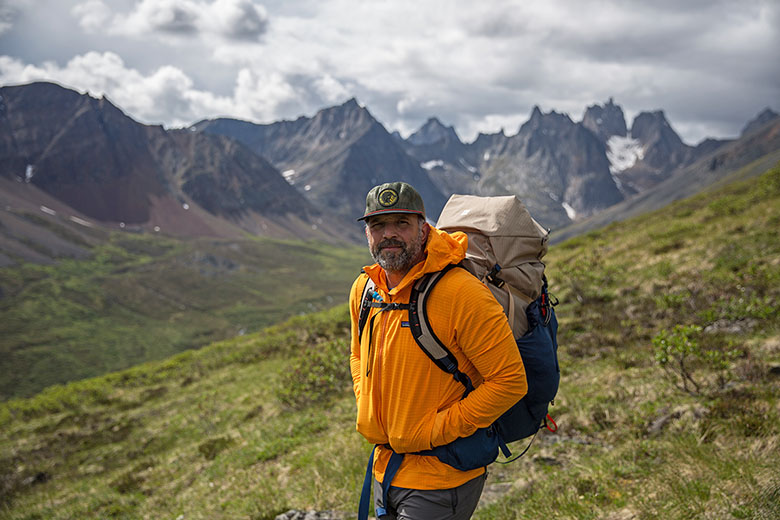
Price: $219
Weight: 14.2 oz.
Fleece weight: Light/midweight
What we like: Highly weather-resistant, breathable, and hardwearing—a great match for demanding pursuits like climbing and backcountry skiing.
What we don’t: Loose fit doesn’t wick moisture well and can make it tough to add a shell overtop.
See the Patagonia R1 TechFace
Patagonia has one of the most extensive fleece collections on the market, and their performance-focused Regulator (R) series is designed with active use in mind. Straddling the softshell and fleece categories, the R1 TechFace Hoody takes their popular R1 and adds more weather and abrasion resistance. We took the hoody camping, backpacking, and rock climbing around British Columbia and the Yukon and came away with mostly positive feedback. The baggier fit doesn’t wick moisture well and is too large to wear on its own, but it’s a great match for climbers and skiers who want a baselayer and light shell in one. Below we break down our experiences with the R1 TechFace Hoody. To see how it stacks up to the competition, see our articles on the best fleece jackets and best softshell jackets.
Editor's note: Patagonia updated the R1 TechFace for spring 2024, with notable changes including a stronger sustainability focus, slightly stretchier—albeit 0.4-ounce heavier—construction, and changes to the chest pocket (it’s now external rather than internal) and cuffs (they have elastic bindings rather than stretch knit). Our review and photos below are of the past-generation model, although we’ve outlined the changes where applicable and will report back after testing the latest version.
One of the biggest selling points of the Patagonia R1 TechFace Hoody is its breathability, which is ideal for cool-weather activities like hiking, backpacking, and climbing. I wore the jacket in a range of conditions, but perhaps the most revealing test was camping in B.C.’s Cathedral Lakes backcountry, when a wildfire moved in quickly and forced us to pack up camp in a hurry and evacuate to a nearby helicopter landing pad. Upon receiving direction from the rangers, we quickly donned our 65-liter packs and jogged several miles uphill to the evacuation point. Once we received word that wildfire crew had the situation under control a few hours later, I realized I had been wearing the R1 the entire time. Although I was definitely warm, I was able to comfortably exert myself with a fully loaded pack without overheating, which is in large part due to the jacket’s grid-like patterning that allows air to flow through.
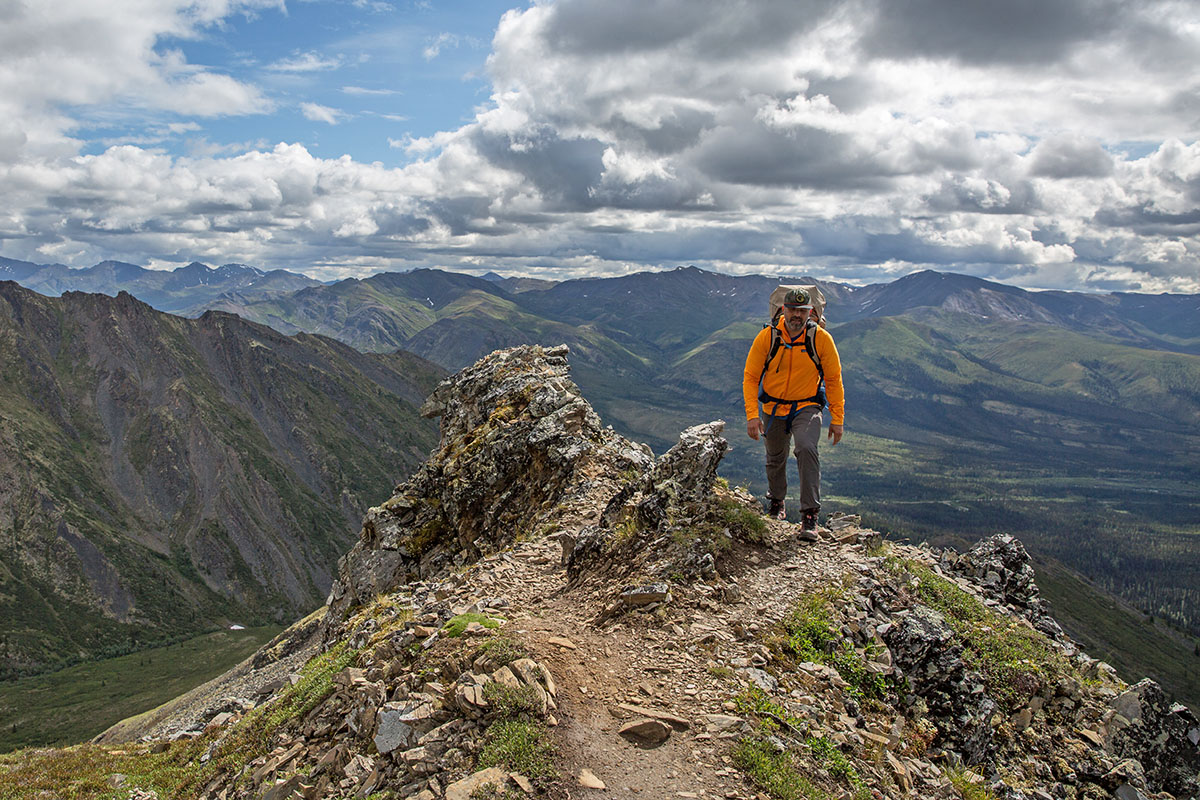
All that said, since the R1 TechFace Hoody doesn’t fit snugly against the skin (more on this in “Fit and Sizing” below), I found it doesn’t wick sweat as well as more fitted fleeces like Arc’teryx’s Kyanite Lightweight Hoody. And it wouldn’t be my first pick on mild days—in warmer temps, I overheated quickly while ascending steep, lengthy sections of trail. I’m looking forward to testing its performance this winter on cold backcountry ski approaches, but so far, I’d say it’s a nice match for shoulder seasons and cool alpine environments.
As I touched on above, the R1 TechFace’s warmth limits it to colder days. If I’m exerting, the temperatures are mild, and the sun is out, I’m very quick to warm up in the jacket. That said, I should admit that I do run particularly hot, and the aforementioned breathability makes this jacket suitable for most shoulder-season activities and conditions. All in all, it’s become my go-to layer for sitting around camp in cooler temps, packing my van in the morning before an early adventure, and during more static activities like belaying (I typically pair the R1 with a light merino baselayer). And because of the fairly generous fit, I can easily wear the R1 in much cooler conditions by adding a down or synthetic jacket underneath.
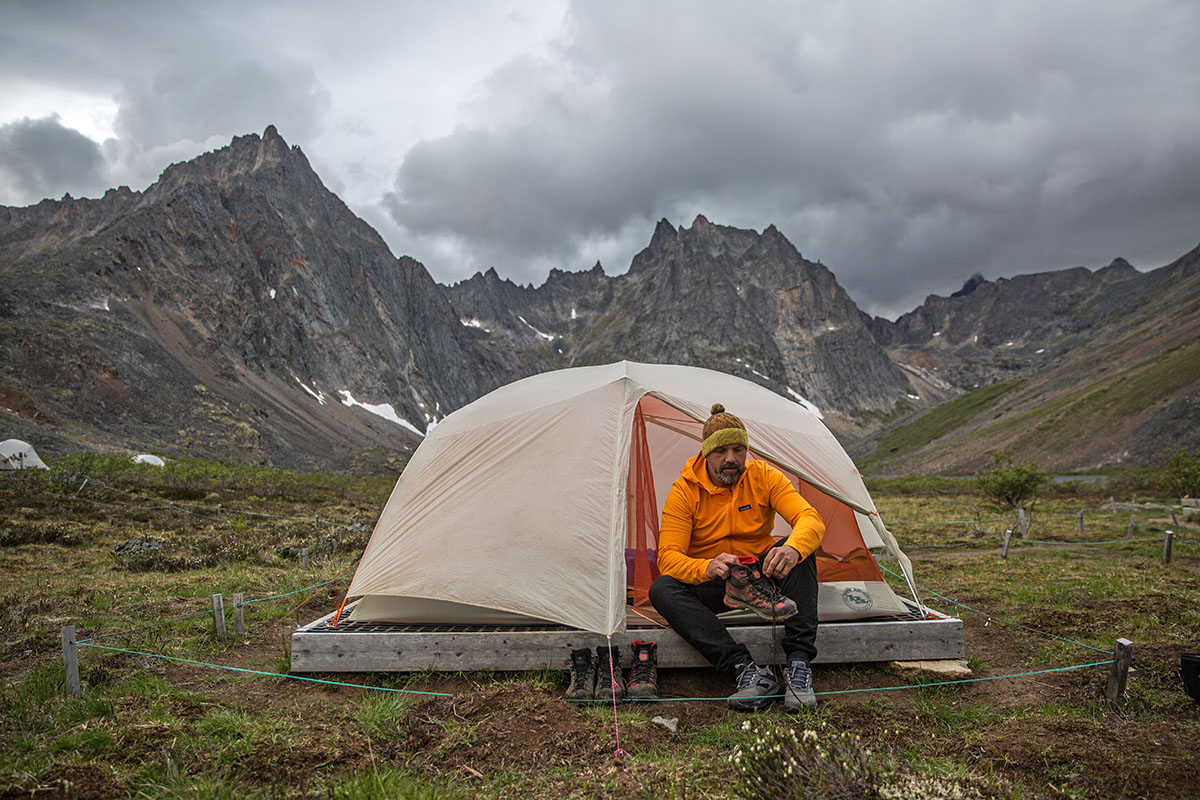
As far as comfort goes, the R1 TechFace is decently pliable and cozy, but it lacks the super soft and supple feel that you get with a standard fleece and has much less loft than Patagonia’s own standard R1 and R2. That said, while wearing a short-sleeve baselayer underneath, I had no issues with abrasion or rubbing, and the inner fabric felt comfortable against bare skin. The cuffs also sport a small section that’s softer than the rest of the grid-patterned build and proved to be ideal for wiping my brow or nose (note: The 2024 R1 TechFace swaps in more basic but easier-to-secure elastic cuffs). All told, I wore the R1 for everything from sitting around camp in cooler temperatures to mid-hike breaks and the aforementioned wildfire evacuation and have little to complain about—just don’t expect pillowy softness.
Fleeces and softshells aren’t the best options for protecting against harsh weather—for this, we turn to hardshells and rain jackets—but the R1 TechFace Hoody does an admirable job in light rain and wind. For starters, the jacket has a durable water repellent (DWR) finish that helps moisture bead up on the surface rather than soaking through, and the double-weave fabric is highly wind-resistant. Despite very blustery conditions in the Yukon’s Tombstone Territorial Park, the R1 put up a great defense against light to moderate gusts. When the mercury dropped and the wind was really howling, however, I did need to don my hardshell jacket to fend off the chill. And on a long stretch of hiking in sustained rain, the shoulders of the hoody did wet out and take a while to dry. In the end, the R1 can pull double duty as a shell in a pinch, but it’s best suited for mild days and non-inclement conditions.
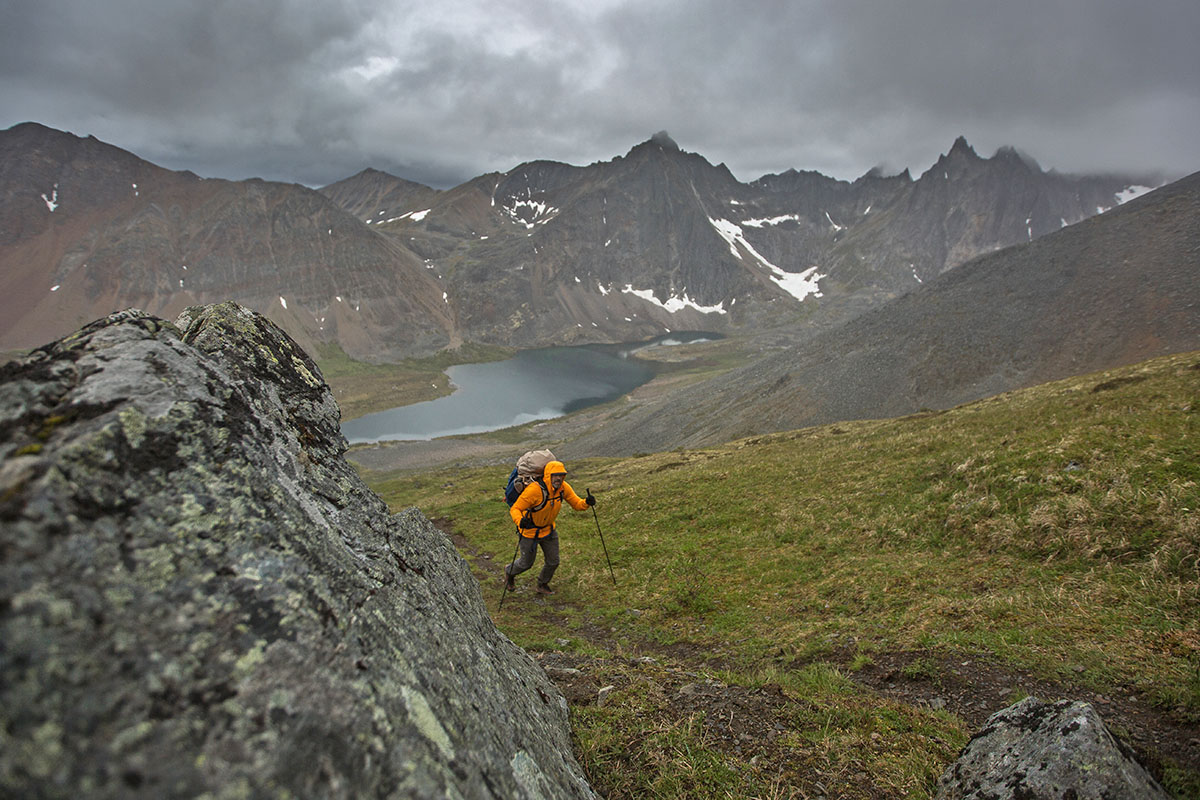
My R1 TechFace Hoody in a men’s size large clocked in at 15.3 ounces, which falls at the lighter end of the softshell spectrum but is fairly heavy for a performance-focused fleece. (Note: The past-generation version we tested was listed at 13.8 oz., while the latest model is a little heavier 14.2.). For reference, Arc’teryx’s similarly backcountry-ready Kyanite Lightweight Hoody weighs less at 10.6 ounces, their warmer Kyanite Hoody is 15.7 ounces, and Patagonia’s own R1 Pullover Hoody—a more breathable but less abrasion- and weather-resistant alternative—comes in at 11 ounces. For a step up in warmth, Patagonia also makes their R2 in a TechFace version for an additional $10 (1 lb. 2.3 oz.). On the bright side, the R1 does stuff easily into its own hood and can be further compressed with the drawcord, although I wish it had a dedicated stuff pocket (it does fit in its pocket, but the zipper isn’t designed for this).
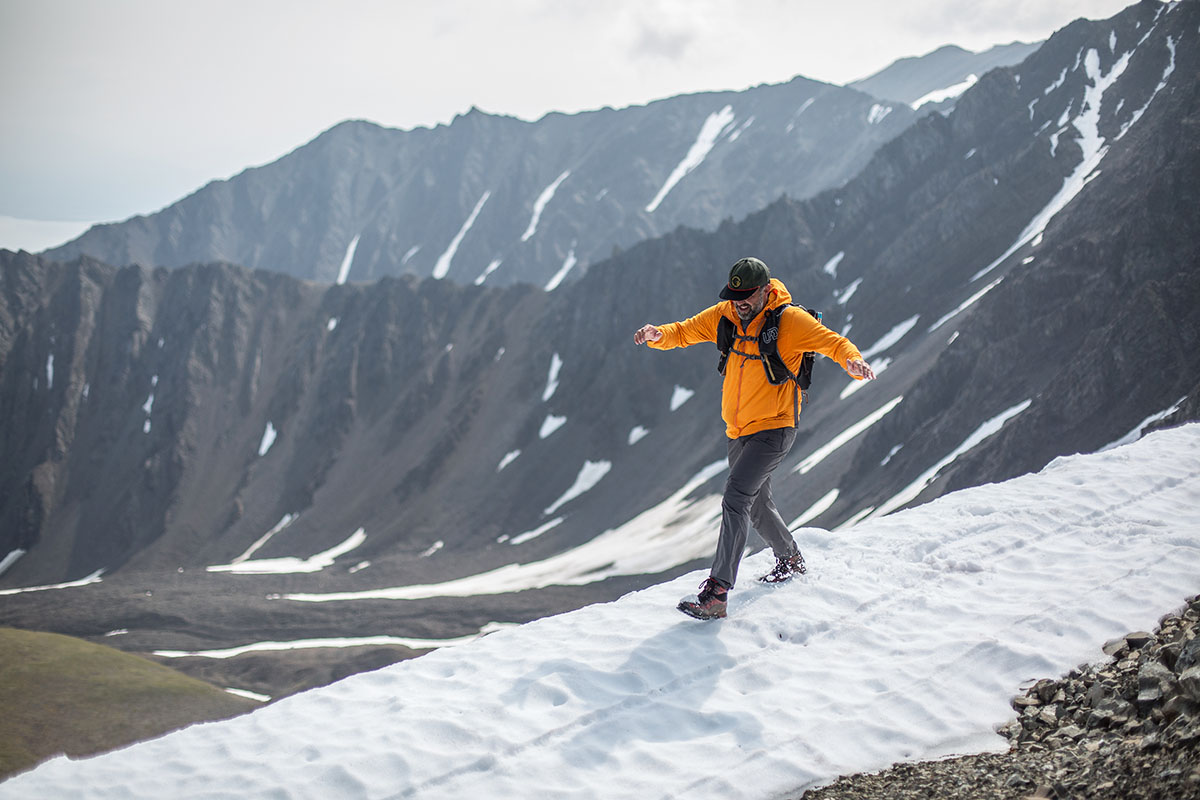
The R1 TechFace’s hood is quite versatile: It's designed to fit close to the head when cinched and can easily (and comfortably) be worn under a climbing or ski helmet. However, I found it was also large and elastic enough to stretch over an alpine climbing or even low-profile ski helmet, although it can restrict movement at the neck while fully zipped (undoing the main zip a couple inches helps). Additionally, the hood features a laminated visor that does a nice job keeping moisture out of my eyes. And as far as adjustability goes, the hood sports three drawcords (note: The latest version has just one) for dialing in fit, which allow for great customization but can be tough to toggle with gloves on.
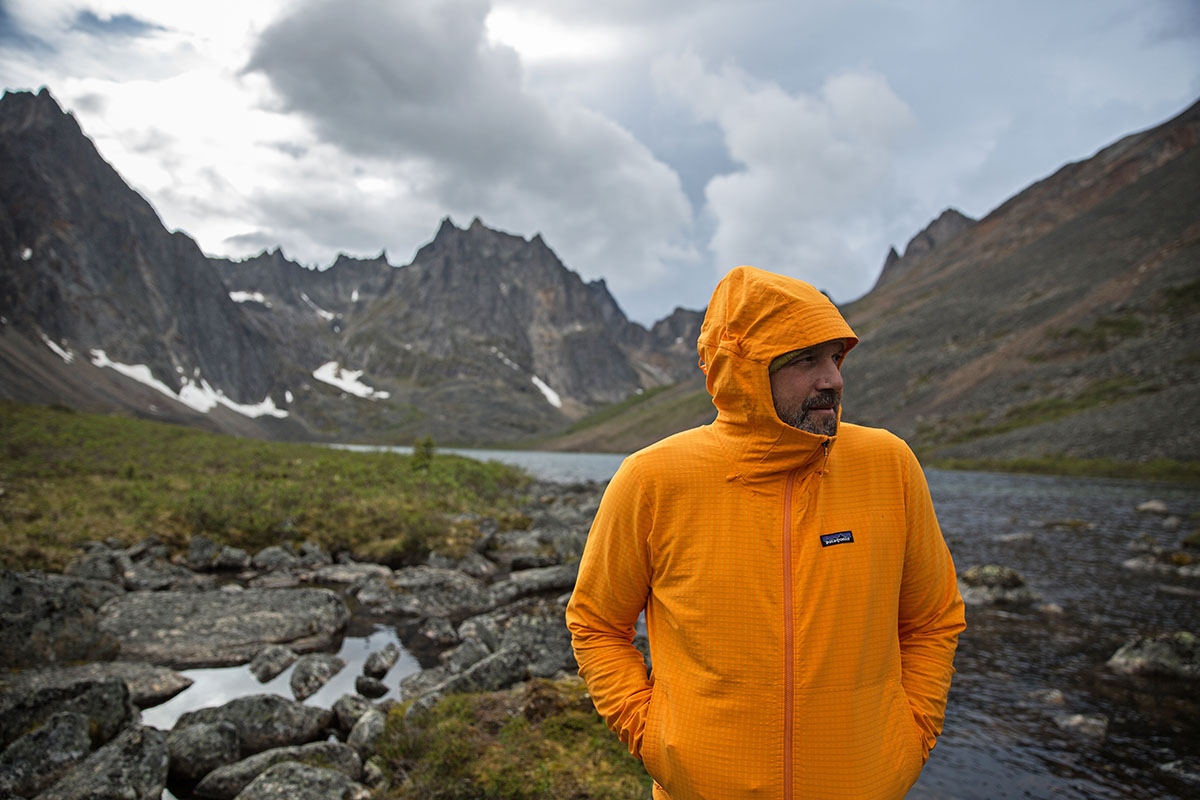
The R1 TechFace Hoody comes decently equipped for stashing the essentials with two large hand pockets and one small internal chest pocket. (Note: Patagonia moved the chest pocket to the exterior with the 2024 update, which we're happy to see, as internal zippers are more of hassle to access and toggle under a sternum strap or while wearing gloves.). The hand pockets are placed high enough to allow access while wearing a climbing harness or backpack hipbelt, and the chest pocket is ideal for stowing smaller items that you don’t need frequent access to, such as car keys (this reduces the risk of losing critical items in the backcountry).
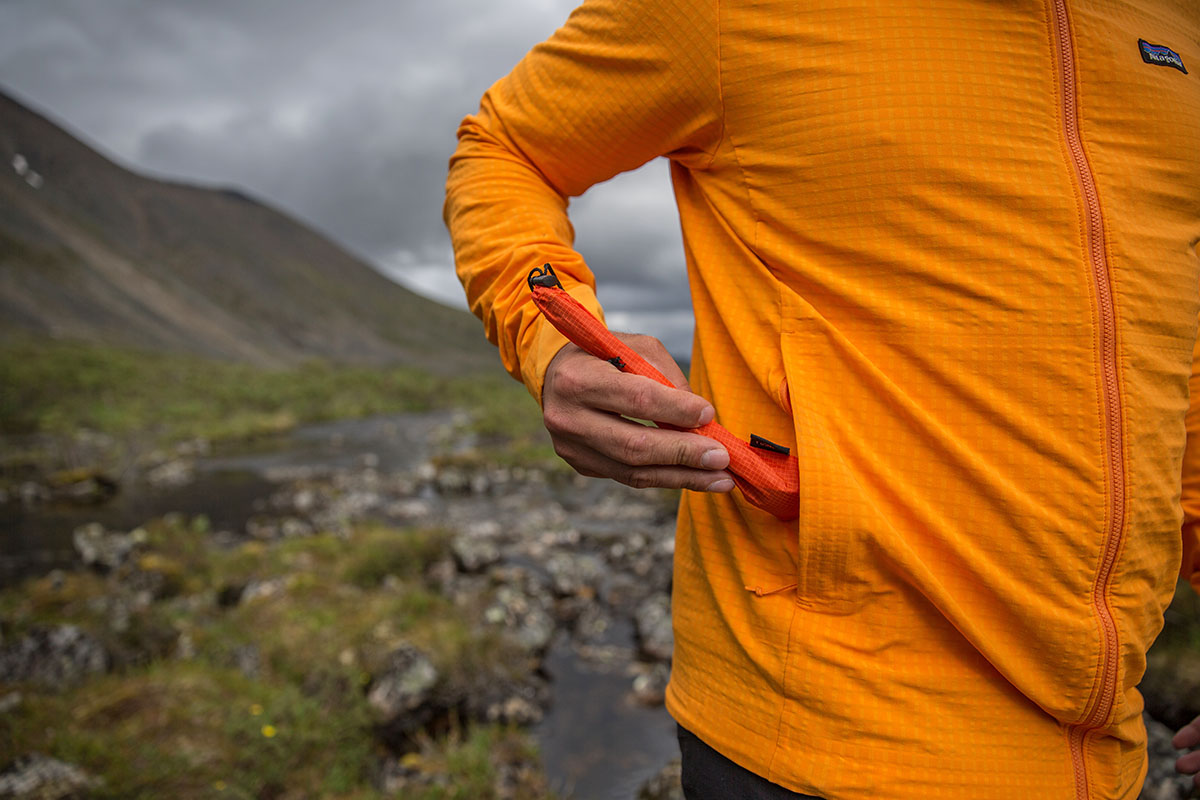
Patagonia is known for their quality craftsmanship, and the R1 TechFace Hoody is exactly what we’ve come to expect from the brand. The fabric is a mix of 92% polyester and 8% spandex (note: The latest version is slightly stretchier with 90% polyester and 10% spandex), which feels decently soft against the skin and offers great mobility for activities like backpacking and climbing. Further, all features are well executed and holding up well, from the adjustable and functional hood to the snag-resistant cuffs and cinchable hem. Finally, the jacket has decent everyday appeal with a clean look and classy styling.
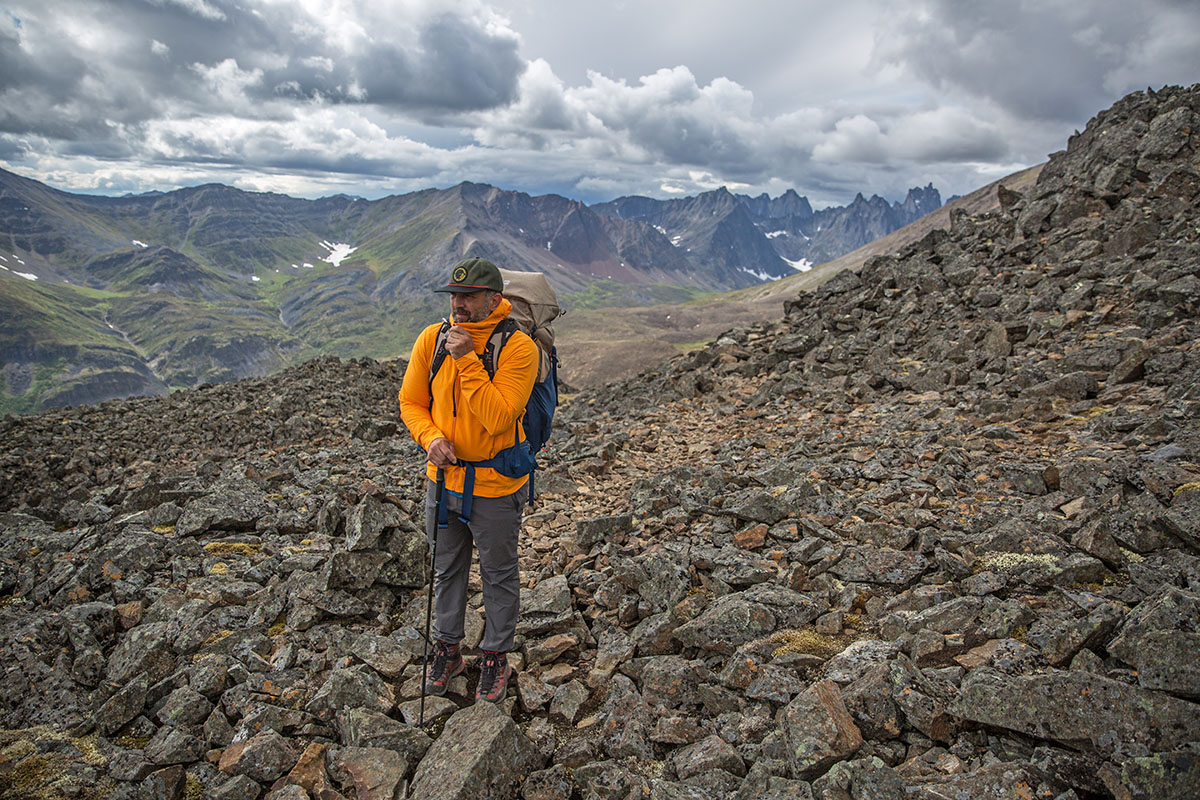
I ordered my usual men’s size large in the R1 TechFace Hoody and found it to fit surprisingly generously given the “slim” designation. I wouldn’t go as far as calling it boxy, but I think “relaxed” is a more appropriate moniker. This can be a good thing for those who plan to layer underneath—I was able to wear a lightweight fleece as a baselayer and throw on my Patagonia Torrentshell 3L overtop when the weather turned—but it’s not a great next-to-skin layer (the baggier fit doesn’t wick moisture as well as a more fitted piece). That said, the jacket is the perfect length at the arms, waist, and shoulders for me, and the healthy dose of spandex and articulated patterning add a nice dose of stretch that makes it very easy to move around in.
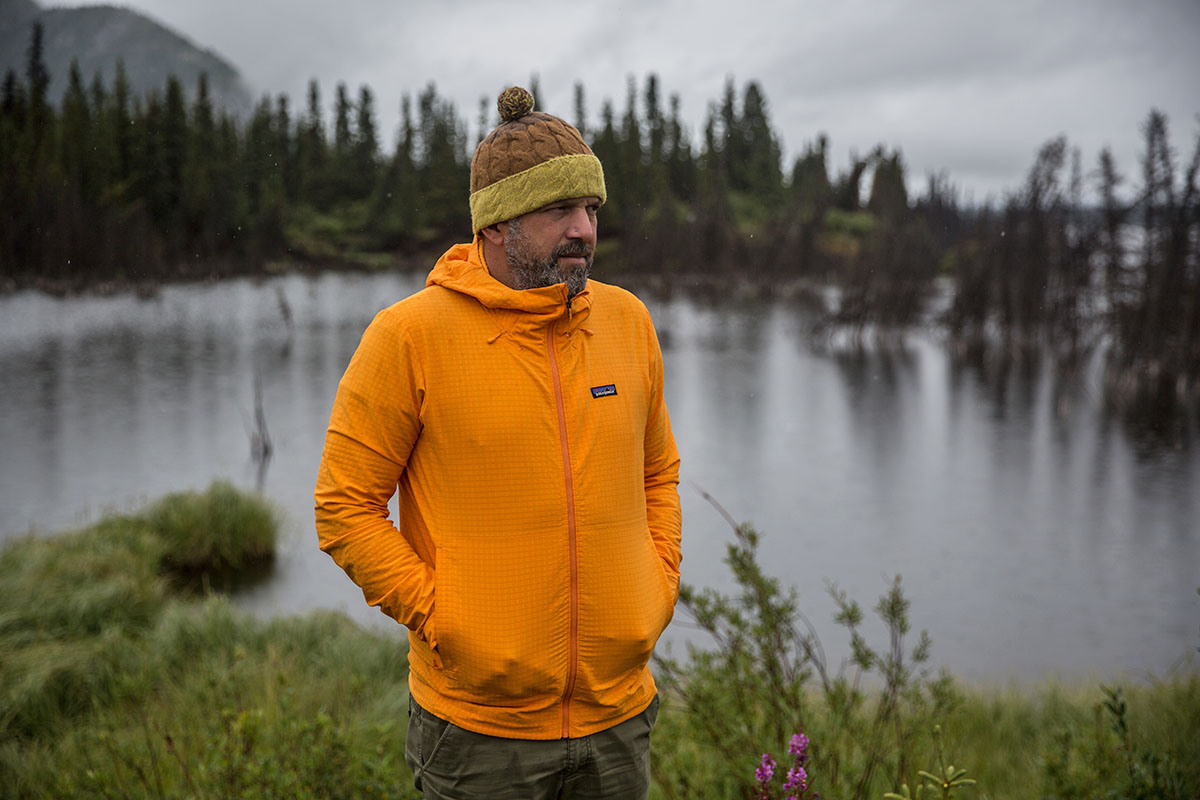
As expected from the brand, the R1 TechFace Hoody embodies Patagonia’s strong focus on sustainability. In addition to using mostly recycled materials for the shell fabric, Patagonia also opted for solution dyeing to create the colorways, which requires considerably less water usage and carbon emissions than standard dyeing practices. The hoody is also Fair Trade Certified, which indicates that Patagonia put extra money into production to help ensure workers are compensated fairly and can fund community projects, healthcare programs, and more (you can read more about the program here). Finally, Patagonia switched to a PFC/PFAS-free DWR finish with the latest update, which forgoes the use of harmful perfluorinated chemicals.
We brought the men’s R1 TechFace Hoody into the Yukon and B.C. backcountries for testing, but the R1 collection includes a number of other variations. It’s also sold in a non-hooded version for $20 less and a 2.9-ounce drop in weight, although given the jacket’s climbing intentions, we think it’s worth spending up for the hoody. On the women’s side, the CrossStrata bears a very strong resemblance to the R1 TechFace and is offered in a few different styles: the R1 CrossStrata Pullover ($149), R1 CrossStrata Jacket ($169), and R1 CrossStrata Hoody ($189). However, despite a similar overall construction (including the same mix of materials), the women’s CrossStrata Hoody boasts a stretch fabric at the shoulders for added range of movement, has a lower-profile hood that’s not designed to fit over a helmet, features an additional drop-in pocket inside the external chest pocket, and has only partial elastic around the cuffs.
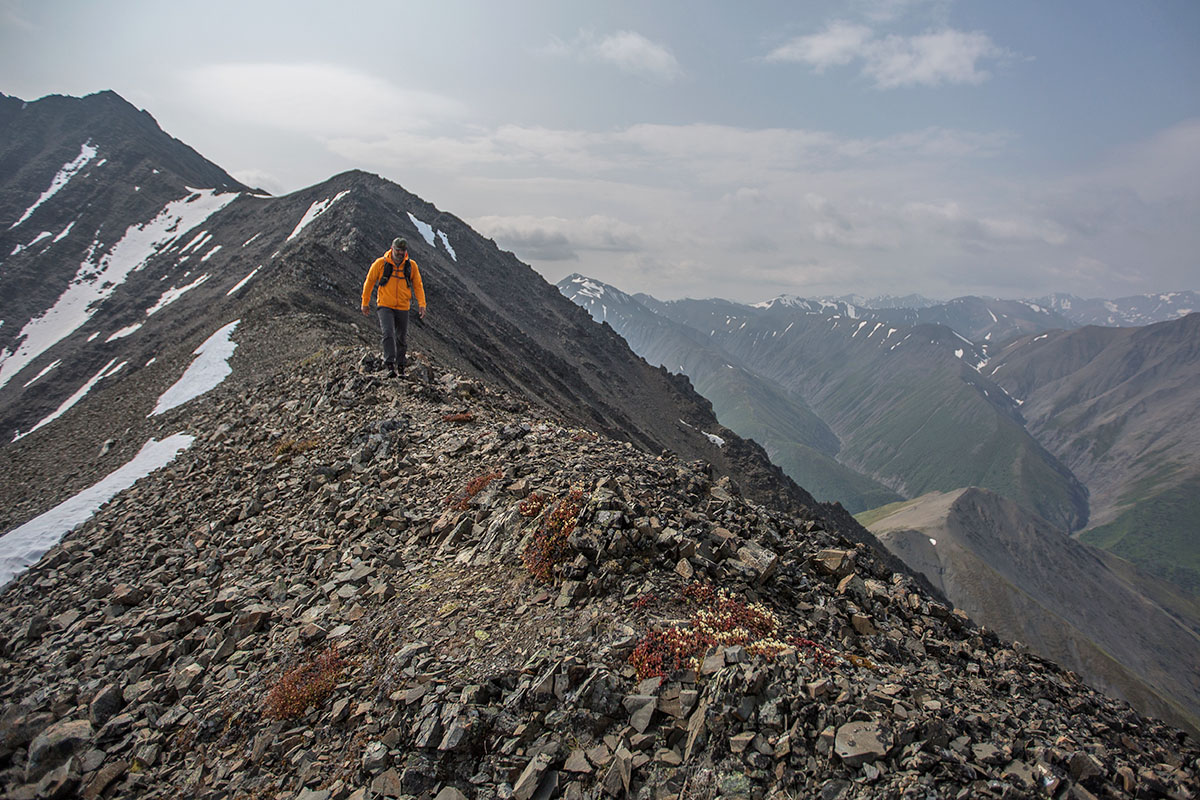
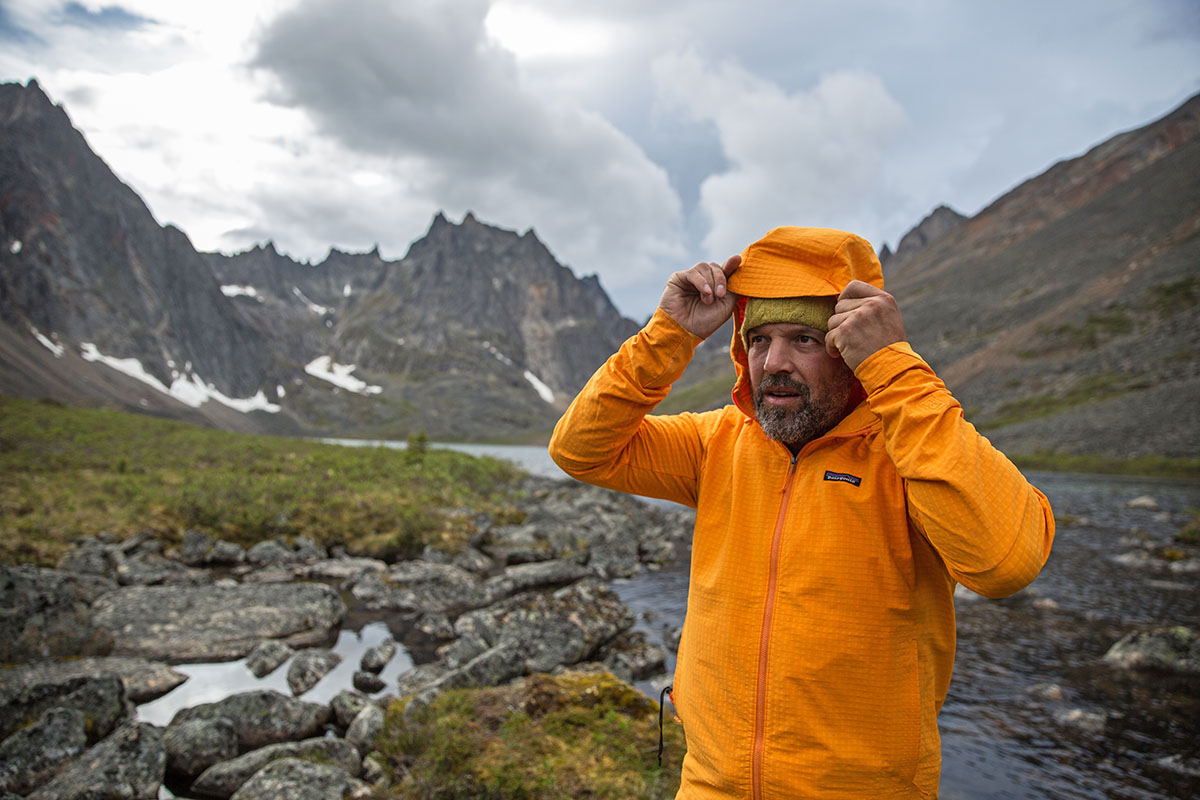
| Jacket | Price | Weight | Category | Construction | Pockets |
|---|---|---|---|---|---|
| Patagonia R1 TechFace Hoody | $219 | 14.2 oz. | Casual/performance | 90% polyester, 10% spandex | 3 |
| Patagonia R2 TechFace Hoody | $229 | 1 lb. 2.3 oz. | Casual/performance | 92% polyester, 8% spandex | 6 |
| BD Cefficient Storm Hoody | $180 | 12.7 oz. | Performance/casual | 92% polyester, 8% elastane | 3 |
| REI Hyperaxis 2.0 | $149 | 15.8 oz. | Performance/casual | 50% polyester, 40% nylon, 10% spandex | 3 |
| Arc’teryx Gamma Lightweight | $260 | 11.5 oz. | Performance/casual | 86% nylon, 14% elastane | 4 |
Patagonia’s R1 TechFace Hoody straddles the fleece jacket and softshell categories, with good all-around warmth and enough weather resistance and durability to wear as an outer layer in mild conditions. For a step up in warmth, Patagonia also makes a TechFace version of their R2 fleece. We consider the R2 TechFace Hoody a nice cold-weather alternative to the model tested here: Like the R1, the R2 is durable, water- and wind-resistant, and breathable for active pursuits. However, the R2 is heavier at 1 pound 2.3 ounces, uses a bit more polyester and less spandex in the build (read: slightly less mobility), and boasts more storage with six total pockets, including two chest, two hand, and two internal drop-in pockets. The R2 is also noticeably softer against the skin with a higher-loft fleece interior, although the added warmth limits the jacket’s appeal to truly cold days. For milder temperatures, shoulder-season outings, or high-output pursuits, we prefer the thinner and more breathable R1.
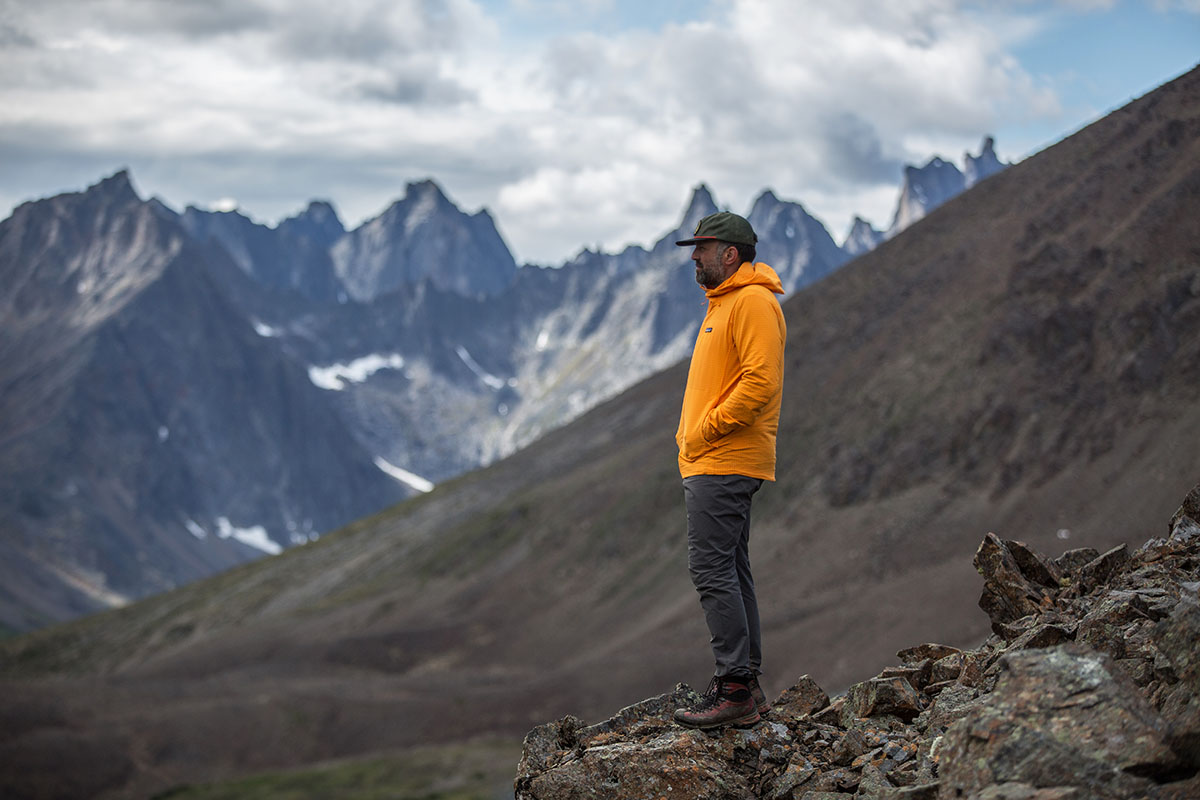
Black Diamond recently released an intriguing competitor to the R1 TechFace in their Coefficient Storm Hoody. For around $40 less than the Patagonia, the Coefficient boasts a similar overall construction including a gridded back for warmth and breathability with a weather- and abrasion-resistant exterior. You also get an identical pocket layout, although the hood design is more basic—it's not alpine helmet-compatible or adjustable—and the hem omits a drawcord for dialing in fit and sealing out drafts at the waist. We do appreciate that the Coefficient packs down into a hand pocket, which the R1 TechFace does not, and weight is a bit more competitive at 12.7 ounces. We have yet to try the Coefficient Storm for ourselves, but all signs are positive that it's a well-built—albeit slightly less feature-rich—R1 TechFace alternative.
Next up is a budget-friendlier alternative to the R1 TechFace: REI's Hyperaxis Fleece Jacket 2.0. For a significant $70 less than the R1, the Hyperaxis has similar performance intentions with Polartec's Power Stretch Pro fleece that's highly stretchy and breathable, a scuba-style hood that fits nicely under a helmet, and hipbelt/harness-compatible hand pockets (in addition to a zippered exterior chest pocket). We also appreciate the REI's thumb loops that make it easier to layer overtop, and the Polartec fabric has a notably softer next-to-skin feel. However, weight goes up to a relatively hefty 15.8 ounces. And while entirely subjective, we consider the R1 TechFace the more streamlined and better-looking piece—it's hard to beat Patagonia's top-notch fit and finish. In the end, the REI is a perfectly viable alternative for those looking to save, but the more premium R1 TechFace has become a stable among the climbing community, which says a lot about its long-term durability and all-around performance.
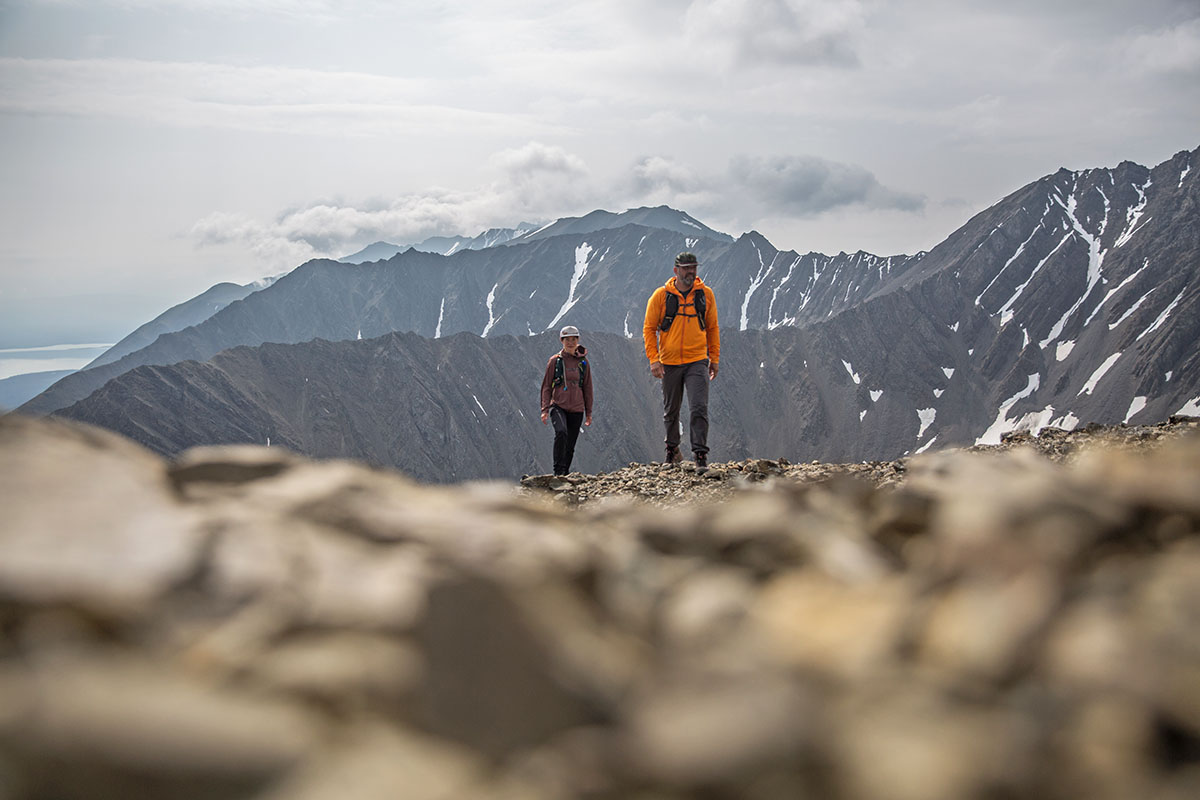
A final competitor to consider is a true softshell: Arc’teryx's Gamma Lightweight Hoody. Like the R1 TechFace, the Gamma has a durable outer fabric, breathes reasonably well (although not as well as the R1), and has a roomy cut that allows for layering underneath but doesn’t sacrifice range of motion. You also get technical features like a helmet-compatible hood with a laminated brim, articulated patterning for excellent mobility, and a tall collar to help seal out the elements. The Gamma is pricey at $260, but it's impressively lightweight (11.5 oz.), and we consider it the better outer layer and a superior protector against wind and rain. For use as both a baselayer and light shell, however, the R1 is the more versatile piece.
If you’re thinking about buying gear that we’ve reviewed on Switchback Travel, you can help support us in the process. Just click on any of the seller links above, and if you make a purchase, we receive a small percentage of the transaction. The cost of the product is the same to you but this helps us continue to test and write about outdoor gear. Thanks and we appreciate your support!
Depending on the seller, most products ship free in the United States on orders of $50 or more. International shipping availability and rates vary by seller. The pricing information on this page is updated hourly but we are not responsible for inaccuracies.